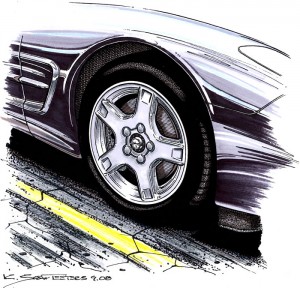Dateline: 7.19.11
A Historic Look Back at the Wheels that Vettes Ride On!
After much anticipation, the all-new C5 Corvette was released as a 1997 model. The new design was truly a “modern” Corvette. However, many of the basic components can be traced all the way back to the ‘57 “Q-Corvette” proposal. Yes, forty years before, Zora Arkus-Duntov was thinking about advanced hardware that included and all-aluminum, fuel-injected engine, an aluminum-case transaxle, inboard-mounted rear drum brakes to reduce unsprung mass, a lightweight pan chassis similar to the 356 Porsche, and four-wheel independent suspension. Fast forward forty years and you have the C5 Corvette. Lightweight alloy wheels eliminated the need for the inboard-mounted rear brakes and the new hydroformed frame rails replaced the pan body structure. Other than those details, body styling, and a lot of computerized components, the new C5 Corvette was the realization of the ‘57 Q-Corvette proposal.
As tire and wheel size grew to handle increased horsepower, it was now essential that the wheels be as light as possible for a production car. Additional unsprung mass from larger wheels and tires is the kiss of death for improved handling. The new C5 was riding on 17” x 8.5” front wheels and 18” x 9.5” rear wheels. In comparison, the ‘96 C4 Corvette Continue reading “Corvette Wheels Pt 3 of 3 – 1997 to 2009”


